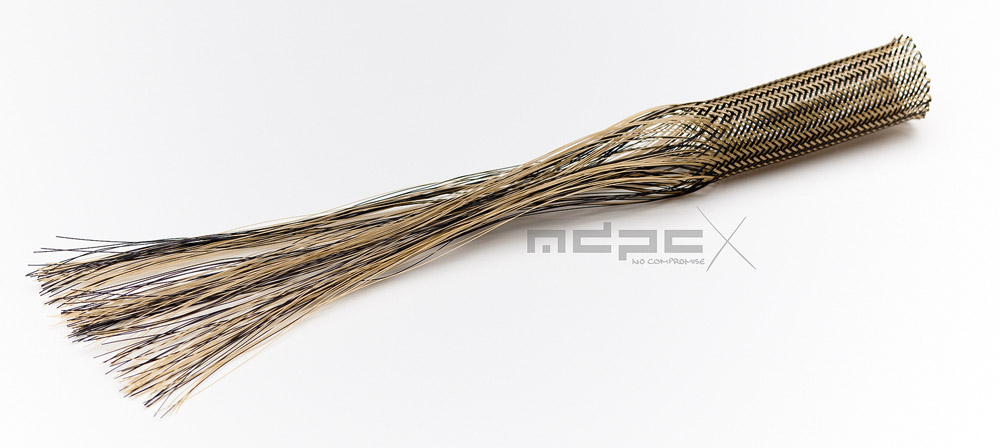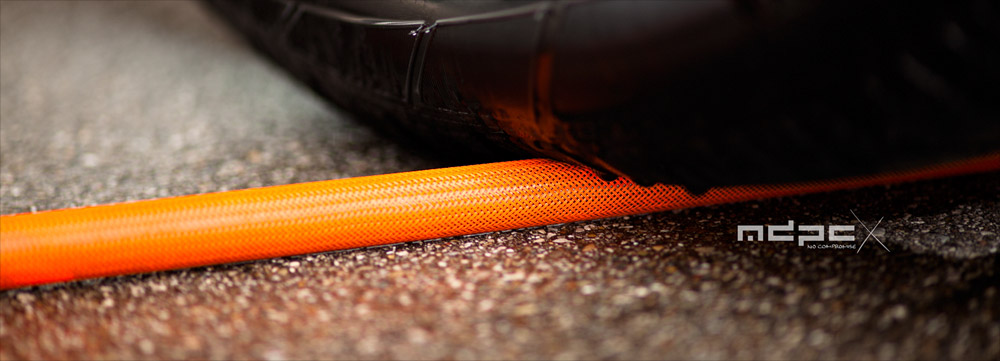This is sleeve.

Sleeve is often called „cable sleeving“, because it’s mostly used on cables and wires, but you can use it on any kind of object. You’re only limited by your creativity and ideas.
Cable sleeving is a woven, expandable, flexible, tubular construction, which you can put over objects. Without an object inside the sleeving, it can be oval or flat, especially on bigger sizes. The sleeving will adjust to the shape of the object, if the object isn’t smaller than the smallest measure of the sleevings diameter range.
It’s like a sock with 2 open ends. Socks come in size ranges for different feet sizes. Cable sleeving comes in size ranges for different object sizes as well.
Each sleeving size has a diameter range. This range covers a maximum and minimum diameter. It does so, because the sleeving is expandable and contractable (when pulled lengthwise).
Sleeving isn’t like rubber though! You can’t pull the sleeving longer than the material itself is made to be.
Important to remember about diameters and lengths:
- Sleeving is offered in lengths, which refer to its maximum length at its minimum diameter. It’s measured while the sleeving is pulled / stretched lengthwise without any object inside.
- On an object, which diameter is at the minimum of the sleeving’s expansion range, you will have 100% of the original sleeving length. E.g. 10 meters of sleeving will cover 10 meters of the object.
- On an object, which diameter is at the maximum of the sleeving’s expansion range, you will have 50% of the original „empty“ length. E.g. 10 meters of sleeving will cover 5 meters of the object.
- The weave of the cable sleeving will have a maximum coverage („not seeing the color of the object underneath“) close to its maximum and minimum diameters. In the middle of its expansion range, the weave is opened the most.
Material

Non or almost-non expandable sleeves, as you find on ropes or shoelaces, aren’t covered in this guide, because the fixed diameter size doesn’t need any specific knowhow. If it fits, it fits, if not, not.
Expandable cable sleeving is typically made from modern thermoplastics (PET), which is extruded to filaments (like fishing ropes) at the necessary size. These filaments are the base for the weaving process, which creates the final product. The strands in the weave of an expandable product are clearly visible and part of the high-tech aesthetics. PET is recycleable.
Protective properties

Cable sleeving isn’t just beautiful. It originates from the automotive and aerial industry, where it’s used to protect cables, hoses and wires. MDPC-X cable sleeving is identically used in the German automotive industry. It’s good to remember the following properties for your projects when you use MDPC-X PET:
- Heat resistance of PET: Can be used constantly at temperatures between -58°C to +155°C. Short term peaks of 215°C can also be handled without structural degradation.
- Water repellent, stain resistant. No absorption of water and dirt (in opposite to Nylon, which absorbs water / dirt). Cable sleeving is very easy to clean.
- Abrasion resistance: Protects the sleeved object from wear and material degradation. You can walk over it the whole day, sharp edges won’t cut it so easily, no fraying / hairing as cotton materials do over time.
- Resistance to chemicals like oil, cleaning agents, gasoline and substances like sweat and salt water. No color degradation due to its included UV protection.
- Self-extinguishing properties opposing to Nylon materials, which can burn suddenly and quickly.
Congratulations!
You now understand what cable sleeve is, what you can do with it and what it can do for you. Let’s see which objects can be sleeved.